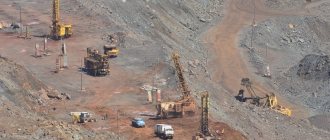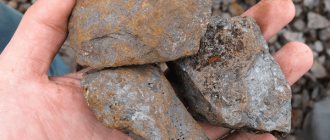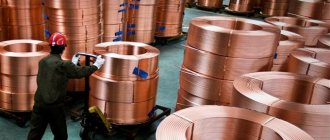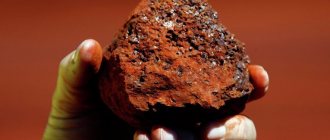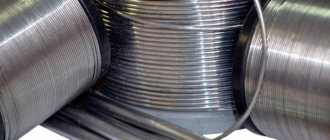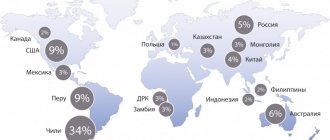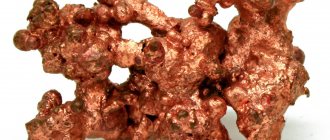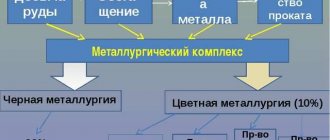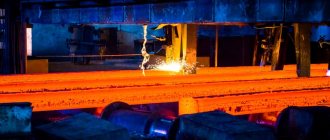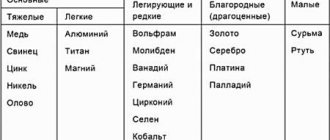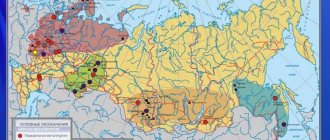Why is ore so important?
Man has learned to obtain various benefits from the earth for his existence since ancient times. Cultivation of the land allows him to grow food, and the extraction of minerals from its depths and their processing provides raw materials and fuel for a variety of purposes.
It was from the moment that man began to mine iron that a completely new stage began in his development. Today, life without metal can no longer be imagined - it has become so entrenched in all its spheres. Until the beginning of the twentieth century, the largest volume of metal ore mining was allocated to iron ore.
Despite the fact that iron is contained in many rocks, only the most economically viable ones are mined, which contain the largest amount of metals and are suitable for processing in terms of their qualities.
Characteristics
Iron-bearing mineral formations make up approximately 5% of the Earth's crust, making it the fourth most abundant element in the world.
Ore contains many homogeneous bodies - minerals, and their quantity and the presence of iron itself serve as the main criteria determining its quality. An important role is also played by the amount of impurities, chemical, physical properties and a number of other indicators. Based on the content of ferrous compounds, the following types are divided:
- very rich (iron exceeds 65%);
- rich (50%-65%);
- average (25%-45%);
- poor (25% or less).
The composition of the ore and its other characteristics affect its further use. In particular, it can be used to make cast iron or steel. At the same time, a large number of harmful impurities complicate the metal production processes and increase their cost. Some chemical elements are purposefully extracted from it.
Iron ore deposits
Iron ore deposits are usually divided according to their origin. In total, in geology it is customary to distinguish the following types:
- Magmatogenous, formed as a result of high temperature influences.
- Exogenous, originating in river valleys. Their formation was influenced by sedimentary processes and rock weathering.
- Metamorphogenic, which were formed in sedimentary deposits under the influence of various transformation processes, high temperatures and pressure.
Today, over 50 countries are involved in the iron mining industry and Russia is among the top five. In terms of the quantity of reserves, it ranks first and is only slightly inferior in terms of the quality of the iron itself.
World reserves
There are deposits of iron-containing minerals on every continent. Their resources are distributed as follows (in descending order):
- European states.
- Asian countries.
- African continent: South Africa, Algeria, Liberia, Zimbabwe, Angola, Gabon.
- South and North America.
Iron ore deposits have been discovered in the territories of 98 countries. Today, their real figure is 212 billion tons. But scientists believe that the world's deposits of this strategic raw material can amount to 790 billion tons.
In percentage terms, iron ore reserves by country are distributed as follows:
Iron Ore Mining Data
- Ukraine – 18%.
- Russia – 16%.
- Brazil – 13%.
- Australia – 11%.
- China – 13%.
- India – 4%.
- The rest – 25%.
Ore layers vary in iron content. They are rich (more than 50% Fe), ordinary (25–50%), poor (less than 25%). Therefore, in terms of iron content, their reserves are distributed differently:
- Russia – 19%.
- Brazil – 18%.
- Australia – 14%.
- Ukraine – 11%.
- China – 9%.
- India – 4%.
- The rest – 25%.
Of all mined iron-containing minerals, 87% are of low quality (iron content 16–40%). Such raw materials require enrichment. Russia produces only 12% of high-quality ferrous compounds, with an iron content of more than 60%. The highest quality raw materials for metallurgy are mined on the Australian mainland (64% Fe).
It is estimated that at the current level of ore production, the supply of iron to the world economy will be 250 years.
How ore beneficiation occurs
The size of ore layers can reach up to two meters, so they must be crushed before enrichment. The following methods are then used:
- Gravity separation. To separate large and small particles, mechanical action is applied to them - crushing, rotation, etc. It is considered the best and lowest cost method, and therefore has become widespread.
- Magnetic separation. Using a magnet, iron ore is separated from impurities, which are washed off with water.
- Flotation. Metal particles are oxidized with the help of air, which attaches them to itself. Only homogeneous and finely ground rock is suitable for its implementation.
- Complex method. When only one of the above methods is not enough to obtain the necessary raw materials, they are combined. Sometimes the procedure requires repeated repetition.
Next, the resulting iron ore raw materials are sent to production, where metal will be made from them. In its pure form, it is used quite rarely, but its various alloys, due to their individual characteristics, have become widespread.
The largest iron ore deposits in Russia
Most of the Russian reserves are usually attributed to Precambrian sedimentary rocks. These are mainly red, brown and magnetic iron ores, differing in their characteristics. However, only 12% of them are high-quality rocks whose iron content exceeds 60%.
In addition, the geological conditions at Russian fields are quite complex, which poses difficulties in their development, and they are located quite unevenly throughout the Russian Federation. The largest of them are based in the Central Federal District. Over 55% of the total volume of iron mined in the country comes from these deposits.
Karelia and the Murmansk region can also boast that their deposits provide 18% of all ore, and Gusevogorskoye, located in the Sverdlovsk region, provides 16%. Let us next consider the largest deposits of the Russian Federation.
Development of the iron ore industry in Russia and the USSR [edit | edit code ]
The iron ore industry in Russia has existed for more than 300 years. However, in Tsarist Russia the level of iron ore production was small and amounted to 9.2 million tons per year in 1913. Russia ranked fifth in the world in iron ore production after the USA, Germany, England and France. By 1917, iron ore production had declined to only 5.3 million tons per year. The main centers of the iron ore industry in the pre-revolutionary period were the Urals and Krivoy Rog [1].
The rapid development of the iron ore industry of the USSR began during the first five-year plans. In 1930, iron ore production in the USSR exceeded the level of 1913. Before the Great Patriotic War, about 30 million tons of ore were mined per year. During the war years, production levels were halved. But by 1950, annual production of iron ore reached 43.2 million tons. The dynamics of development of the iron ore industry in the post-war years are presented in the table. In 1958, the USSR came out on top in the world in iron ore production. In 1990, its production exceeded 236 [9] million tons.
In the USSR, the iron ore industry experienced accelerated development in connection with the industrialization of the country during the first five-year plans. The USSR had significant reserves of high-grade iron ore and virtually unlimited reserves of low-grade iron ore. In terms of the volume of balance reserves of ore and the volume of production of commercial iron ore, the USSR ranked first in the world [10]. Huge resources of iron ore made it possible, with appropriate development of the production and technical base, to fully satisfy the growing needs of the ferrous metallurgy of the USSR and a number of socialist countries for commercial ore. The open method of iron ore mining, the most economical and efficient, has undergone accelerated development. The share of open-pit mining increased from 54.3% in 1959 to 79.2% in 1970. The mines and mines that develop deposits using the underground method were technically re-equipped.
Read also: Methods for repairing screwdriver batteries
The growth of ore production in the USSR in million tons is shown in table [11]
| 1913 | 1940 | 1950 | 1960 | 1970 | 1980 | 1985 | 1990 |
| 9,2 | 29,9 | 39,7 | 105,9 | 195,5 | 244,7 | n.d. | 236 |
The production of low-grade ores, which were processed at processing plants, increased sharply. The share of beneficiation plant products (concentrates) in marketable ore increased from 53.6% in 1965 to 62.3% in 1970. From concentrates, the production of sinter with the addition of fluxes has expanded. At the same time, a new method of pelletization was developed - pelletization of concentrates in special installations (pelletizers), followed by roasting and production of pellets, which made it possible to increase the productivity of blast furnaces and reduce coke consumption.
Due to the increase in the production of low-grade ores, the iron content in raw ore decreased on average from 40.8% in 1965 to 37.3% in 1970, and its content in marketable ore increased over these years from 56.7% to 58.8% , in concentrate - from 50.0% to 61.8%.
The geography of the location of mining enterprises in the industry has changed significantly. The most important ore base of the European part of the USSR was the Krivoy Rog iron ore basin. Enterprises in this basin supplied iron ore raw materials to factories in the Dnieper region, Donbass and other regions, as well as a number of socialist countries. A high share of ore production in the basin was ensured by five mining and processing plants (GOKs) for open-pit mining and processing of ferruginous quartzite: - Southern GOK (launched in 1955), Novokrivorozhsky GOK (launched in 1959), Central GOK (launched in 1961 year), Northern GOK (launched in 1964) and Inguletsky GOK (launched in 1965).
The second most important and large-scale ore base of the country and the main ore base of the factories in the Central part of the USSR were the enterprises of the Kursk Magnetic Anomaly (KMA). KMA reserves are many times greater than those of the world's largest deposits. Such large enterprises as Mikhailovsky GOK, Lebedinsky GOK and others were built here.
In the east of the country, deposits in the Urals, Siberia and Kazakhstan were being developed at an accelerated pace. In the Urals, in the Sverdlovsk region, the Kachkanarsky GOK and the Severo-Peschansky mine were built.
The ores of the powerful Angara-Pitsky iron ore basin in the Krasnoyarsk Territory and the Angaro-Ilimsky iron ore region in the Irkutsk region became the basis for the development of metallurgy in Siberia. The Korshunovsky Mining and Processing Plant was built, ore production at the mines of the Kemerovo Region was increased, and mines were put into operation in the Krasnoyarsk Territory, supplying the Kuznetsk Combine (Kemerovo Region) with ore.
Iron ore industry in post-Soviet Russia [edit | edit code ]
The main volume (92.6% in 2006) of raw ore at Russian enterprises is mined by open-pit mining in 29 quarries. In the largest quarries (Lebedinsky, Mikhailovsky, Stoilensky, Northern Kachkanarsky GOK, Kostomuksha) with a productivity of more than 20 million tons in 2006, 70% of iron ore was extracted, and in three quarries (Kovdorsky, Main, Western Kachkanarsky GOK) with a productivity of 10-20 million tons of ore production amounted to 16% (40.63 million tons).
The share of the 8 largest mining and processing plants (Lebedinsky, Mikhailovsky, Kachkanarsky, Stoilensky, Kostomuksha, Kovdorsky, Olenegorsky, Korshunovsky) in open-pit mining of raw ore in Russia in 2006 reached 243.4 million tons and amounted to 96% of all open-pit mining. Their average weighted depth for production is 273.7 m; the deepest of them are Lebedinsky (355 m), Kovdorsky (339 m), Stoilensky (328.5 m).
Iron ore in Russia is mined underground in 11 mines and the underground mine of the Olenegorsk Mining and Processing Plant, the total production of which in 2006 amounted to 20.43 million tons. Maximum production was achieved at the mine named after. Gubkin plant "KMAruda" (3992 thousand tons) and the Sheregesh mine (3480 thousand tons), the minimum - at the Sideritovaya mine (523 thousand tons). The Tashtagol mine mine has the maximum depth (800 m), the minimum depth is the Sideritovaya mine (280 m).
In 2006, the Russian iron ore industry produced 103.7 million tons of iron ore raw materials, i.e. 6.9 million tons more than in 2005 [12].
The raw material base of each metallurgical region has its own specific characteristics, which largely determine the technology of the entire cycle of the metallurgical plant and its economy. As we already said in the section “what is iron ore?”, iron ore reserves on our planet are estimated at approximately 150 billion tons, and the richest countries in terms of iron are: Russia, Brazil, Australia, Ukraine, China, India and USA.
First, let's look at the most significant iron ore in Ukraine.
Krivoy Rog field
in the area of Krivoy Rog gives. The ore, locally obtained concentrate and produced pellets are used at the Krivoy Rog Metallurgical Plant and are also exported abroad. The ore lies at a depth of up to 500 m, but quartzites come to the surface. Therefore, development is carried out in both open and closed ways. Reserves of rich ores (hematites and martites) are estimated at 1.2 billion tons, and reserves of quartzites (magnetite and oxidized hematite) - up to 18 billion tons.
Open pit mining of iron ore
The average iron content in the ore is about 55%, and in the mined magnetite quartzites - 35-37%. The gangue consists almost entirely of silica. The ore does not contain harmful impurities. The rich ore is crushed on site and sorted by particle size. The 0-10 mm fraction is sent to sintering, and >10 mm is sent directly to blast furnace shops. Magnetite quartzites are enriched by magnetic separation. From the concentrate, containing about 65% iron, agglomerate, pellets are produced, or it is sent to metallurgical plants. The Kremenchug field, located northeast of Krivoy Rog, is its continuation. It contains 1.1 billion tons of magnetite quartzites containing about 30% iron, which are enriched at the Poltava Mining and Processing Plant built here to 65% iron, and pellets are produced from the concentrate.
Read also: Acetylene water and hg2
Beloretskoye field
, located near the city of Zaporozhye, is represented by rich hematite ores containing about 63% iron. The reserves amount to 500 million tons. The Zaporozhye Mining and Processing Plant located here processes the mined ore, after which it is sent directly to the factories.
Kerch field
brown iron ore has reserves of about 2 billion tons. The ore is an oolitic (granular) brown iron ore containing 34-39% iron. Low iron content, high content of harmful impurities (about 1% phosphorus, 0.05-0.15% arsenic) and enrichment difficulties have led to the fact that this deposit is currently not used.
Russia is the richest country in iron ores, and the Kursk magnetic anomaly
, the largest iron ore region in the world. The magnetic anomaly of this area, which is 50–100 km wide and 400–600 km long. is caused by a thick thickness of steeply dipping quartzite layers, representing practically inexhaustible reserves of iron. The ore layers are located at a depth of 35-580 m. The registered reserves of the Kursk magnetic anomaly exceed 40 billion tons, and the promising ones - up to 200 billion tons. The main reserves of the deposit are represented by quartzites, mainly magnetite, containing 35-40% Fe, and rich hematite -martite ores containing 50-61% Fe. In addition, these ores contain 0.1-0.6% S, 0.02-0.09% P and 10-20% hygroscopic moisture.
A negative feature of waste rock is the increased (up to 2.5-3.5%) alumina content, which worsens the properties of the slag. The largest deposits are Mikhailovskoye
(near the city of Kursk),
Lebedinskoye
and
Stoilenskoye
(near the city of Gubkin). They are developed by open-pit mining, quartzite is enriched, pellets are produced from the concentrate at mining and processing plants, and part of the concentrate is sent directly to the plants.
The photo shows Lebedinsky GOK
We also bring to your attention a short video about the work of the Stoilensky Mining and Processing Plant, so that you can imagine how the extraction and further processing of iron ore occurs.
The Yakovlevskoye, Gostishchevskoye and other deposits located near Belgorod are promising, the reserves of which amount to about 25 billion tons of rich hematite-martite ores, which, however, occur at depths of about 500 m.
In the Murmansk region and Karelia there are several iron ore deposits, which are the base of the Cherepovets Metallurgical Plant.
Olenegorskoye field
, located south of Murmansk, consists of ferruginous quartzites containing about 31% iron. Its reserves amount to about 600 million tons. They are enriched on site using the magnetic-gravity method at the Olenegorsk GOK to a content of 62% Fe, and the concentrate is supplied to sinter plants.
The photo shows the Olenegorsk GOK
Eno-Kovdorskoye field
, located west of Olenegorsk, is represented by magnetite quartzites containing 31-32% Fe, has a thickness of about 500 million tons. Its peculiarity is the main waste rock, which has a basicity index of 1.6 and a high phosphorus content, which decreases after magnetic enrichment at the Kovdorsky GOK from 2.7-2.9% to only 0.18-0.20%. The concentrate containing 64-65% Fe is sent to plants for agglomeration.
Kostamuksha field
magnetite quartzites with a capacity of about 1.2 billion tons are located in the Karelian Autonomous Soviet Socialist Republic, on the border with Finland. Quartzites containing 30-35% Fe, about 0.07% P and 0.2% S are enriched at the mining and processing plant built here to a content of 63-65% Fe, from which pellets are produced, sent to the Cherepovets Metallurgical Plant.
Kachkanarskoye field
titanomagnetites is located north of the city of Nizhny Tagil, has reserves of about 12 billion tons. The extremely low iron content (only 16-17%) increases to 61% during the enrichment process. The ore contains about 0.15% vanadium, which is an important feature. The Kachkanarsky GOK produces sinter and pellets and supplies them to the Nizhne Tagil Metallurgical Plant.
The initial base of this plant was the deposits of the Tagilo-Kushvinsky iron ore region, which have now been practically developed.
Magnitogorsk field
magnetite ores, which played a huge role in the development of the Magnitogorsk Iron and Steel Works, have also been depleted due to long-term intensive exploitation.
To the south of Novokuznetsk is the Gorno-Shorsky iron ore region, formed by the Temir-Tausky, Odrabashsky, Tashtagolsky and other deposits of magnetite and martite ores containing 30-49% Fe. A distinctive feature of some ores is the presence of zinc (0.1-1.1%) and high sulfur content. Reserves are estimated at 200 million tons. Ores and concentrates are sintered at processing and sintering factories, and the sinter is sent to the Novokuznetsk and West Siberian metallurgical plants. However, their main base is the Abakan and Teyskoye fields, located east of Novokuznetsk, in Khakassia. Their reserves amount to about 2 billion tons of magnetite ores.
There are a number of large iron ore deposits located in Eastern Siberia.
To the north of Krasnoyarsk in the Angara-Pitsky iron ore region there are the Nizhneangarskoye, Ishimbinskoye and other deposits. The ores of these deposits are mainly hematite, difficult to enrich, contain about 30-40% Fe, the waste rock is siliceous-alumina. The reserves of this area are about 1.4 billion tons.
North of Irkutsk there is a large Angaro-Ilimsky iron ore region, combining the Korshunovskoye, Rudnogorskoye and other deposits. Reserves are estimated at 900 million tons. The ore of these deposits is magnetite, contains 38-50% Fe, 0.03% S and 0.8% R.
Let's look at the largest foreign iron ore deposits.
The main iron ore base of the US
is the Lake Superior region, which produces about 80% of the ore mined in the country. In this area, the largest amount of ore is mined in Mesabi County, from which the ore takes its name. Mesabi ore contains 50-52% Fe, 9-10% SiO2, 0.77% Mn, 0.09% P and about 11% moisture. Ore reserves are estimated at 1 billion tons; in addition, the deposit contains about 30 billion tons of quartzites (locally called taconites), of which about 5 billion tons are magnetite. The latter are mined and enriched from 31 to 64% Fe, then subjected to agglomeration into agglomerate or pellets. This and other deposits satisfy the needs of the US iron and steel industry only partially.
Read also: What is a pressure roller for?
A characteristic feature of the metallurgical industry of developed capitalist countries (USA, Japan, Germany, etc.) is the import of large quantities of iron ore and pellets from large deposits of the world, usually located in developing countries. The high quality of these ores, the low cost of their extraction and processing, and low transportation costs ensure the efficiency of such work. Below is a brief description of the largest iron ore regions in the world.
Canada
has significant reserves of iron ore and has a developed iron ore industry - mining, enrichment and agglomeration in the form of agglomeration and pellet production. The main deposits are located in the provinces of Quebec, Newfoundland (Newfoundland Island, Wabana field), etc. The reserves of Canada's main deposits are estimated at 5.5 billion tons, of which about 3 billion tons are located in the Quebec-Labrador region. The ores of this deposit are hematites and magnetites, contain about 53% Fe, have siliceous gangue, do not contain sulfur, but contain 0.03-1.1% P. The resulting concentrate and pellets are exported to the USA, England and Germany.
Venezuela
has large reserves of high-quality ores, which are estimated at 2.2 billion tons. Hematite ores, with a very high iron content (63-68%), do not contain sulfur and phosphorus. About 20 million tons of ore are mined per year, 80% of which is sent to the USA.
Brazil
has huge reserves of high-quality iron ores. Reserves in the state of Minas Gerais (Itabiri, Itabirita deposits) are estimated at 16 billion tons and contain 50-60% Fe. Lump ore contains 66-69% Fe and 0.1-1.5% SiO2, 0.5-1% Al23.
In Australia
deposits with a reserve of about 16 billion tons of hematite and partially limonite ores have been explored. The main deposits are located in Western Australia, near the coast. The largest Brocken deposit contains about 8 billion tons of hematite and hematite-limonite ore, containing 54-69% iron. The ores mined here and the pellets produced locally are exported mainly to Japan through nearby ports.
In India
there are significant reserves of iron ore, which amount to about 20 billion tons. The main deposits are located 300 km west of Calcutta in the states of Bihar, Orissa and Madhya Pradesh, forming together the so-called Iron Belt with total reserves of 8 billion tons of rich hematite ore They contain 60-68% Fe, very pure in sulfur and phosphorus. A negative feature of these ores is the predominance of alumina in the waste rock.
Kursk magnetic anomaly
It is in it that more than half of the total supply of iron on the planet is found. The Kursk Magnetic Anomaly (KMA) is the world's largest iron ore basin. Most of it is located mainly in the following areas:
- Kursk;
- Orlovskaya;
- Belgorodskaya.
It is worth noting that in total its borders affect nine regions of central and southern Russia. Active development is underway at the following KMA fields:
- Stoilensky;
- Mikhailovsky;
- Lebedinsky.
KMA reserves amount to billions of tons, making it the world's largest deposit. However, the explored volumes are only 30 billion tons. Its area exceeds 160 thousand km². The ore mined there is represented by magnetite quartzites and granitoids.
The texture of the ore mined in KMA is multicomponent, and its depth varies from 30 to 650 meters. In the future, there will also be an opening for development of new deposits.
Rating of leaders in iron ore reserves
Those states where deposits of raw materials were discovered at one time carry out non-stop mining work. Low grade materials are most common. In certain parts of the world you can find iron ore with a high amount of “useful” iron.
Sweden
The largest deposits are located in northern Sweden in the city of Kiruna. Today Sweden is one of the leading exporters of raw materials in the world. At the same time, having on the territory of the state only 1% of the total world mineral reserves.
Bakcharskoye field
This deposit is also considered one of the largest ore occurrences in the world. Belongs to the West Siberian basin in the Tomsk region between the Androma and Iksa rivers.
It consists of four iron ore layers overlapping each other in some places. The ore lies at a depth of 200 meters, and on the northern side it reaches 300 meters. With an area of 16 thousand km², the estimated volume of its reserves is over 30 billion tons.
The deposit is well explored and contains high quality ore. The amount of iron in it reaches 57%, and it lends itself well to enrichment, which can increase its content to 97%.
Mined iron ore contains components of metals such as cobalt, titanium, chromium, etc. It is noteworthy that this field was discovered completely by chance, during an expedition to search for oil back in the 60s.
Iron ore mining methods
When developing an iron ore deposit, the depth of the deposits at which the mineral is located plays a very important role. Therefore, there are two methods of extraction - quarry and mine. With the first, the depth is up to 600 meters. To obtain raw materials, the top layer is removed, which does not contain iron-containing minerals. Ore reserves are mined by open pit mining using machinery, and then loaded onto bellows and delivered to enrichment and processing sites.
The advantage of this method is its low cost when compared with the construction of mines. But it causes enormous harm to the ecology of the area. During production, the biosphere is destroyed, and there is a danger of toxins entering water bodies. After mining, the quarries are filled in and the surface is leveled, but it takes many years to restore the natural balance.
The mine method of extracting iron ore is also common in the world. It provides the possibility of deep deposits - more than 1 kilometer. Its cost is much higher, because it is necessary to use a large amount of equipment, equip the mines to prevent collapses and establish a stable system for transporting raw materials.
Olenegorskoye field
The basis of its raw material base is replete with ferruginous quartzites, where magnetite and hematite act as key minerals. Although the rock is located almost at the surface, the main ore body reaches a depth of 800 meters or more, and its length is 32 kilometers.
There are very few harmful impurities in the ore of this deposit, which makes it possible to obtain high-quality metal. Another advantage of Olenegorsk iron ore is its easy concentration. However, the iron content in it is only 31%.
Distribution of forecast resources of the Russian Federation for iron ore
In terms of the availability of predicted iron ore reserves, Russia ranks only third, behind Brazil and the United States. The total amount of ore in the Russian Federation is estimated at approximately 120.9 billion tons. If we consider the reliability of “intelligence data”, then the most accurately determined reserves (category P1) are 92.4 billion tons, the probability of full production is slightly less at 16.2 billion tons (category P2) and the lowest probability of extraction of explored ore is 2. 4 billion tons (category P3). The average iron content is 35.7%. The main part of the resources is concentrated on the KMA (Kursk Magnetic Anomaly), located in the European part of Russia. The deposits located in Siberia and the Far East are of less importance.
